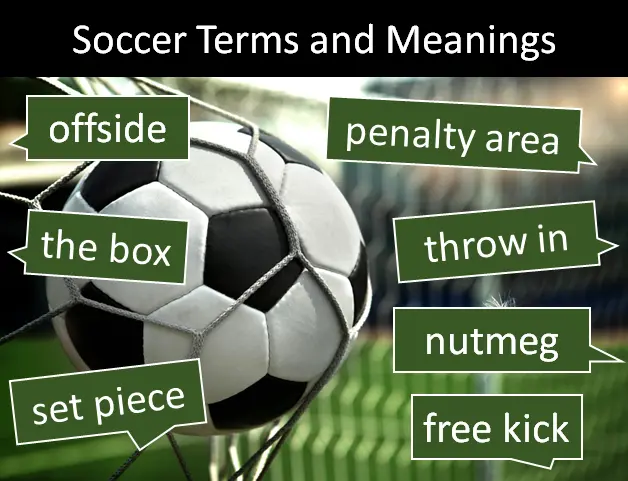List of Common Soccer Terms with Definitions

| Soccer Term | Definition |
|---|---|
Cap |
Caps refers to the number of games a player has played for their country. The term originates from England, where players used to receive actual caps when they played for the national team. Some countries still award actual caps to their players for every international game they feature in. Some others only award them to mark a special milestone, such as a debut or certain number of games played. |
Center Circle |
The center circle of a soccer field is drawn around the center mark, which is at the midpoint of the halfway line and is where the ball is placed to kick off. It is 10 yards (9.15 meters) in radius and indicates how much space the opposing team must give the team with possession while kicking off. See the English FA rules concerning the field of play. |
Corner |
A corner is a type of set piece awarded when the ball is put out of play behind their own goal line by a defending player. The ball is placed in the corner area nearest to where the ball crossed the goal line, as indicated by the referee, and no opposing player may be within 10 yards (9.15 meters) of the ball. See the English FA rules concerning corners. |
Extra Time |
In knock-out competitions such as the World Cup after the initial group stage, games that are tied after 90 minutes of play (plus stoppage time) must play 30 minutes of extra time. Extra time is divided into two halves of 15 minutes, with a one-minute break. In the World Cup there is no "golden goal" rule, as in some other competitions. The 30 minutes must be completed in full. If there is no winner in extra time, the knock-out games must be decided by a penalty shootout. |
Free Kick | A free kick is a type of set piece, awarded when a player commits a foul outside the penalty area. (A foul committed by a member of a defending team in their own penalty area is a penalty.) There are two types of free kick:
See the English FA rules concerning free kicks. |
Goals |
The Goals. A goal is a frame at each end of a soccer field, placed on the center of each goal line. It consists of two vertical posts (each often referred to as "the post") that are joined at the top by a horizontal crossbar ("the bar"). The distance between the inside of the posts is 8 yards (7.32 meters) and the distance from the lower edge of the bar to the ground is 8 feet (2.44 meters). The area in front of the goal is often referred to as the "goalmouth." See the English FA rules concerning the field of play. Scoring a Goal. A goal is scored when the whole of the ball passes over the goal line, between the goalposts and under the crossbar. A player can use any part of their body, except their hands or arms, to score a goal. |
Group Stage |
The group stage of a tournament such as the World Cup is the phase of the competition in which teams are organized into groups and must play each other in order to qualify for the knockout stage. In the World Cup 2022, 32 teams participated in the group stage, organized into eight groups of four. The winner and runner-up of a group all qualified for the knockout stage. |
Kick-Off |
A kick-off starts both halves of a match, both halves of extra time and restarts play after a goal has been scored. At kick-off, all players, except the player taking the kick-off, must be in their own half of the pitch and the opponents of the team taking the kick-off must be at least 10 yards (9.15 meters) from the ball until it is in play (i.e., it has been kicked and clearly moves). See the English FA rules concerning starting and restarting play. |
Knockout Stage |
The knockout stage of a competition such as the World Cup is the phase of the competition in which only the winners of each game play in the next round, until one team is the final winner. In the World Cup 2022, 16 teams qualified for the knockout stage, meaning that the eventual winners had to win four matches after the group stage. |
Nutmeg | A nutmeg is passing the ball through an opposing player's legs and collecting it on the other side. A player that has been nutmegged has been humiliated. It is common for a defending player to grab the player attempting the nutmeg (i.e., commit a foul) rather than allowing the nutmeg to be completed. |
Offside | A player is in an offside position if they are in the opponent's half of the pitch and any part of their head, feet, or body (not the arms or hands) is closer to the opponent's goal line than the second to last opposing player and the ball. (The opposition goalkeeper is usually the last opposing player, but does not have to be.) Play can be stopped and an indirect free kick awarded when an offside player interferes with play. See the English FA rules concerning offside. |
Penalty Area | The penalty area (also referred to as the "penalty box," "18-yard box," and simply "box") is a rectangular area of the pitch that extends 18 yards (16.5 meters) to each side of the goal and in front of it. Within the penalty area is the penalty spot. An arc of a circle with a radius of 10 yards (9.15 meters) from the center of each penalty mark is drawn outside the penalty area. This is known as the penalty arc. Fouls committed by the defensive team within the penalty area, which would be punishable by a direct free kick, may be penalized by a penalty kick. The penalty area has other functions, including:
|
Penalty Kick | A penalty kick (also known as a spot kick) is awarded when a defending player commits a direct free kick offense inside their own penalty area. A player from the attacking team takes a one-on-one shot against the goalkeeper from the penalty spot, which is 12 yards (11 meters) from the middle of the goal. If the goalkeeper parries the shot or the ball rebounds into play from the frame of the goal, any player, including the penalty taker, may play it. See the English FA rules concerning penalty kicks. |
Penalty Shootout |
If a knockout game, such as in the World Cup, ends in a tie after extra time, the winner must be decided by penalty shootout (often referred to as "penalties" or "pens"). In a penalty shoot-out, each team takes turns shooting at goal from the penalty spot, with the goal defended only by the opposing team's goalkeeper. Each team has five shots which must be taken by different kickers. As soon as a team achieves an insurmountable lead, the shootout is ended and the leading team is declared the winner of the game. If there is no winner after five kicks, penalties continue until one team scores and the other misses from the same number of kicks. Unlike with normal penalties, if the goalkeeper parries the shot or the ball rebounds into play from the frame of the goal, the ball is dead and the shot is considered a miss. |
Pitch |
A soccer field is often referred to a a "pitch." At international level, the field of play must be a wholly natural and must comply with the following rules regarding dimensions:
The pitch is divided into two halves by a halfway line, which joins the midpoint of the two touchlines. The center mark is at the midpoint of the halfway line. A circle with a radius of 10 yards (9.15 meters) is marked around it. This is known as the "center circle." See the English FA rules concerning the field of play. |
Set Piece | A set piece is a situation where the ball is returned to play following a stoppage (i.e., a corner, free kick or throw in). Especially for free kicks within the opponents half and for corners, the team that has control of the ball will usually place their players into pre-arranged positions. Set piece specialists are players that are particularly skillful at taking free kicks and/or corners. More rarely, a player may have a particularly long and powerful throw, in which case their team may develop set piece routines for throw ins close to the opponents' goal. |
Stoppage Time |
At the end of each half, the referee may add on extra minutes to compensate for time lost due to stoppages of play (e.g., injuries, free kicks, penalties, substitutions, VAR checks, time wasting by players). That time is known as stoppage time and is often referred to as "injury time," "additional time," or "time added on." Within the final few minutes of each half, the fourth official (an assistant referee not directly involved in controlling the game) holds up an electronic board indicating how many minutes of stoppage time will be played. If further stoppages occur during stoppage time, the referee may decide to add even more time. These extra minutes or seconds will not be indicated by the fourth official (and will usually infuriate the coach and fans of the team holding out for a result!). |
Throw In | A throw in is awarded to the opponents of the player who last touched the ball when the whole of the ball passes over the touchline, on the ground or in the air. All opponents must stand at least 2 meters (2 yards) from the point on the touchline where the throw-in is to be taken. The thrower must:
See the English FA rules concerning throw ins. |
Help Us Improve Cyber Definitions
- Do you disagree with something on this page?
- Did you spot a typo?
- Do you know a slang term that we've missed?
You might also like...
Full List of Emojis
Emojis Used in "Sexting"
Cryptocurrency Terms
Electric Vehicle Terms
Saying I Love You
Search Numbers
Using Numbers to Say Words
Help Us Improve Cyber Definitions
- Do you disagree with something on this page?
- Did you spot a typo?
- Do you know a slang term that we've missed?
Share This Page

If you like Cyber Definitions (or this page in particular), please link to it or share it with others. If you do, please tell us. It helps us a lot!
Create a QR Code

Use our handy widget to create a QR code for this page...or any page.
next up:
Snapchat emojisMore Topics...
emoji library
(send a huge emoji)sex & dating terms
(fine-tune your search)spotting drug abuse
(protect loved ones)saying "I love you"
(learn new ways)encrypting messages
(get sneaky!)gaming terms
(chat like a gamer)spotting grooming
(protect loved ones)numbers in texting
(improve brevity)Spanish slang terms
(get "slangy" in Spanish)using special symbols
(find the codes)coronavirus terms
(remember covidiots)
